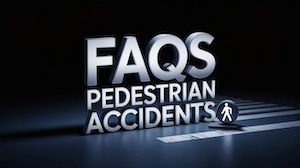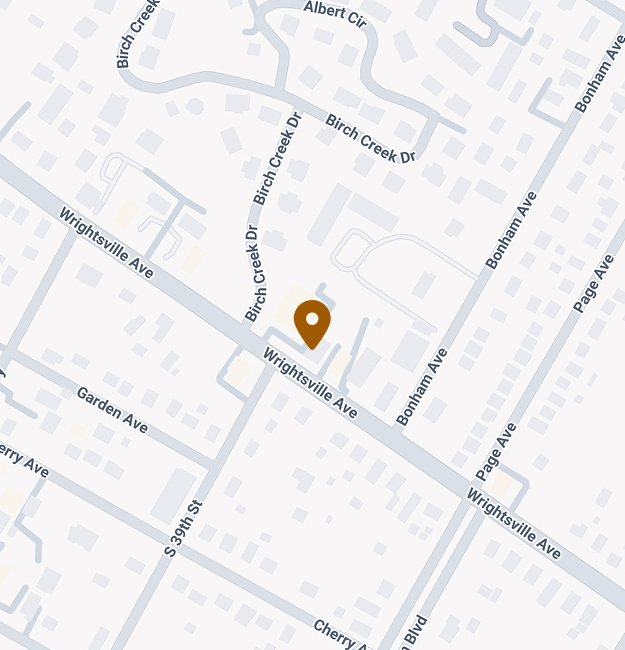FAQs About Pedestrian Accidents in Wilmington, NC
- What Should You Do After a Pedestrian Accident in Wilmington?
- Where Do Pedestrian Accidents Happen in Wilmington?
- Who Is at Fault in a Pedestrian Accident in Wilmington?
- What Types of Injuries Are Common in Wilmington Pedestrian Crashes?
- Should You Speak With the Driver’s Insurance Company?
- How Much Time Do You Have To File a Pedestrian Accident Lawsuit in Wilmington?
- How To Recover Compensation After a Pedestrian Accident in Wilmington
1. What Should You Do After a Pedestrian Accident in Wilmington?

If you have been hit by a car while walking in Wilmington, your first priority is to protect your safety and get medical attention. Whether the crash happened downtown near the Riverwalk, in a crosswalk on Oleander Drive, or near the UNCW campus, pedestrian collisions can be extremely serious. If you are able to do so, move away from traffic and wait for emergency responders to arrive. Call 911 or ask someone nearby to do it for you.
When law enforcement arrives, answer their questions clearly and briefly. You do not need to provide a full statement at the scene, especially if you are in pain or confused. Let the officer know what direction you were walking, whether you were in a marked crosswalk, and anything you observed about the driver’s behavior before impact. The report prepared by the Wilmington Police Department or State Highway Patrol may play a role in how fault is determined later, so accuracy matters.
Try to gather information at the scene. If the driver stopped, get their name, license plate, insurance information, and contact details. If any witnesses saw the crash, ask for their names and phone numbers. Photos can also help. If you have your phone, take pictures of the car, the location, your injuries, traffic signals, skid marks, and anything else that might be relevant. If you are not able to take photos, ask someone nearby to do it.
Get medical care immediately. Go to the emergency room, urgent care, or your primary doctor. Even if you think your injuries are minor, a delay in treatment can make your recovery harder and might be used against you by the insurance company. Injuries like concussions, internal bleeding, or fractures are not always obvious right away. The sooner you are evaluated, the better your medical records can support your claim.
Do not speak with the driver’s insurance company until you have talked to a lawyer. Insurance adjusters are trained to minimize claims and may try to get you to say something that sounds like an admission of fault. Let a Wilmington personal injury lawyer handle that communication for you.
2. Where Do Pedestrian Accidents Happen in Wilmington?
Pedestrian crashes in Wilmington are most likely to occur in areas with high foot traffic and lots of cars and vehicles. Downtown Wilmington, especially near the Riverwalk, Front Street, and Market Street, sees a steady mix of tourists, delivery drivers, and residents. Intersections in this area are busy, and not all drivers yield when they should. The risk increases at night when visibility drops and distractions increase.
The area around UNCW also sees a high number of pedestrian accidents. College students walking to class, crossing at intersections like College Road and Racine Drive, or navigating crosswalks near apartment complexes can be at risk. Drivers in these areas may be in a rush or may not anticipate foot traffic crossing multi-lane roads.
Other trouble spots include Oleander Drive, Kerr Avenue, Carolina Beach Road, and South 17th Street. These corridors carry heavy traffic, have wide intersections, and are frequently used by pedestrians walking to stores, bus stops, and homes. In some areas, crosswalks are spaced too far apart, leading pedestrians to cross mid-block where drivers may not expect them.
Road construction and poor lighting can also contribute to the risk. When sidewalks are closed or blocked, pedestrians may be forced onto the road. When streetlights are out, drivers may not see someone crossing until it is too late. These factors are not always obvious in a police report, but a lawyer who knows Wilmington and its roads can help uncover what contributed to the crash.
3. Who Is at Fault in a Pedestrian Accident in Wilmington?
Liability in pedestrian accidents depends on who had the legal right of way and whether either party acted negligently. In some cases, drivers are at fault for failing to yield, running a red light, turning without looking, or driving while distracted. In some cases, a driver may have been speeding or under the influence of alcohol or drugs (drunk driving).
That said, pedestrians can also be found at fault under certain circumstances. Crossing outside of a marked crosswalk, entering traffic suddenly, walking against a light, or being impaired while walking could all be alleged as contributing factors. In North Carolina, fault matters more than in most states. The contributory negligence rule means that if the insurance company can prove you were even slightly at fault, you may not be allowed to recover any damages at all.
That is why a full investigation can be so important. The crash report is just the beginning. Your lawyer may need to review surveillance footage (if there is any), speak with witnesses, evaluate the timing of traffic signals, or bring in an expert to reconstruct what happened. These steps can make the difference between recovering compensation and being denied outright.
4. What Types of Injuries Are Common in Wilmington Pedestrian Crashes?
Pedestrians hit by vehicles in Wilmington often suffer severe and disabling injuries. The lack of protection between your body and the car means that even a low-speed impact can cause significant harm. Broken bones are among the most common injuries, especially to the legs, arms, ribs, and pelvis. Depending on the angle of impact, a pedestrian may be thrown to the pavement or onto the hood of the car.
Head injuries are also common. A blow to the head can cause a concussion, brain bleed, or skull fracture. These injuries may require hospitalization, imaging studies like CT scans, and follow-up care with a neurologist. Symptoms may include headaches, confusion, dizziness, mood swings, and difficulty concentrating.
Spinal injuries are another serious concern. A hard fall or sudden impact can damage the discs in your back or neck, compress nerves, or cause fractures in the spine. These injuries may not be immediately apparent, but over time, they can lead to chronic pain, limited mobility, and possibly the need for surgery.
Other common injuries include internal bleeding, damage to internal organs, severe lacerations, and torn ligaments. The road surface can also cause abrasions or burns, especially if the pedestrian is dragged or knocked down at high speed.
All of these injuries require documentation. That means going to medical appointments, following treatment plans, and keeping records of everything related to your care. Your lawyer can use that documentation to show the full extent of what you have suffered.
The long-term impact of these injuries varies. Some people make a full recovery after several weeks or months of physical therapy. Others may face permanent limitations, chronic pain, and the inability to return to their previous job. In more serious cases, pedestrians may be left with traumatic brain injuries (TBI), spinal cord damage, or loss of limbs. These types of injuries do not just change your health. They change how you live your life, which should be accounted for in any legal claim.
A Wilmington pedestrian accident lawyer can help you document both the physical and financial consequences of your injuries. That includes medical expenses, lost income, future care needs, and the emotional toll of being unable to work, walk without pain, or enjoy the same activities you used to.
5. Should You Speak With the Driver’s Insurance Company?
No. You are not required to speak with the driver’s insurance company, and in a fair number of cases, it’s not a good idea to do so without legal counsel. Insurance adjusters are trained to settle cases for as little as possible. In the days or weeks after the accident, they may reach out and ask you to give a recorded statement. They might ask what you were doing just before the crash, whether you looked both ways, or how fast you were crossing. These questions are not asked out of curiosity. They are asked to find ways to try to deny or reduce your claim.
North Carolina’s contributory negligence rule makes this even more dangerous. If the adjuster can get you to say something that sounds like an admission of fault, like “I didn’t see the car” or “I was distracted,” they may try to use that to deny your claim entirely. Even a slight misstatement can be costly.
Instead of taking that risk, let a lawyer handle those conversations. Once you are represented, the insurance company should not contact you directly. Your lawyer can deal with the adjuster, gather the evidence, and control how your case is presented. That keeps you protected while giving you space to focus on your recovery.
6. How Much Time Do You Have To File a Pedestrian Accident Lawsuit in Wilmington?
In North Carolina, you generally have three years from the date of a pedestrian accident to file a personal injury lawsuit. This deadline applies to cases involving injury caused by another person’s negligence, including crashes where a car hits a pedestrian. If the pedestrian is killed and the family wishes to pursue a wrongful death case, the time limit is usually two years from the date of death.
These time limits are strict. Missing the filing deadline can result in your case being dismissed, even if the facts are clearly in your favor. Filing a claim with the insurance company does not extend the deadline, and neither does ongoing medical treatment. The only way to protect your right to sue is to file a complaint in court before the statute of limitations expires.
Because some cases require time to gather records, interview witnesses, and consult with experts, it’s smart to speak with a lawyer early in the process. If your injuries are severe or the investigation is complex, your lawyer may need several months to prepare the case before filing a lawsuit (assuming that’s necessary and appropriate). The earlier you start, the more options you may have.
7. How To Recover Compensation After a Pedestrian Accident in Wilmington
Getting fair compensation after a pedestrian accident in Wilmington is not automatic. Even if you were walking in a crosswalk, even if the driver was speeding or distracted, and even if the police gave them a citation, you still need to build a strong case to recover damages. The contributory negligence rule in North Carolina means the insurance company only needs to argue that you share a small fraction of the blame to try to deny your claim altogether. That is why preparation and attention to detail can matter.
A lawyer can help you pursue full and fair compensation for a range of damages. This includes medical bills, including emergency room visits, surgeries, rehabilitation, and follow-up care. It also includes lost income if you are unable to work during recovery, as well as future earnings if your injury prevents you from returning to your old job. Pain and suffering, emotional distress, and loss of enjoyment of life may also be part of your claim.
If the driver was texting, impaired (drunk driving or drugged driving), speeding through a school zone, or otherwise acting recklessly, your case may involve additional legal arguments such as gross negligence. In those kinds of situations, your lawyer may be able to seek punitive damages as well. Punitive damages are not awarded in every case, but they are allowed under North Carolina law when the driver’s behavior shows gross negligence and a conscious disregard for the safety of others.
The value of a pedestrian injury claim depends on the strength of your evidence and the clarity of your legal position. A Wilmington lawyer who knows the local court system, understands the roadways where these crashes happen, and has experience dealing with insurance adjusters can make a real difference in the outcome.
You do not need to handle the process alone. Legal help is available, and the sooner you act, the more time your attorney has to build the case, preserve key evidence, and protect your rights. Call the Law Office of Bradely Coxe to schedule a consultation: 910-834-8400
Address
What People Say?
"Had an excellent experience working with attorney Bradley Coxe to clarify laws and governance practices pertaining to Property Owners Associations in North Carolina. Scheduling a consultation was easy, and Mr. Coxe took the time to read the materials and provide clear...

"After having the opportunity to witness Mr. Coxe's skills in the courtroom ( in an unrelated matter) I decided to employ him in a HOA dispute I was having. He offered excellent and informed guidance in the matter. His promptness was appreciated and his skill apparent...



